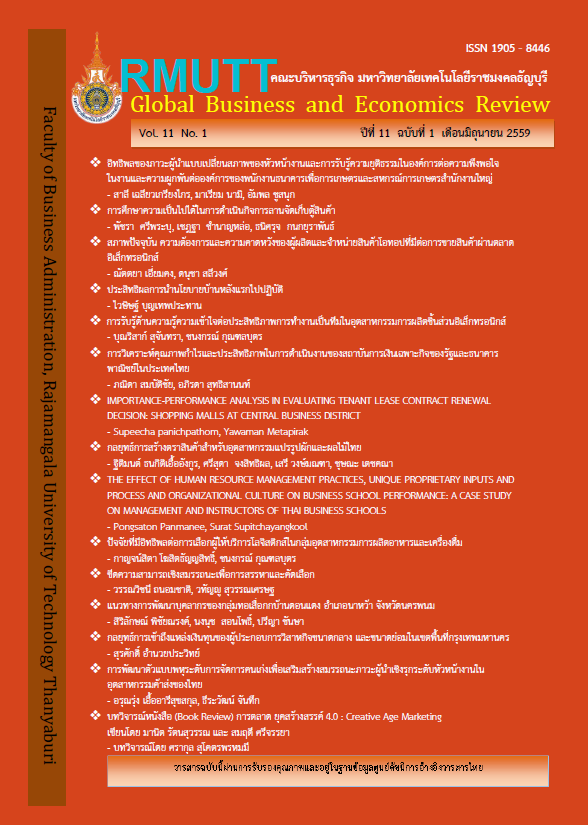THE EFFECT OF HUMAN RESOURCE MANAGEMENT PRACTICES, UNIQUE PROPRIETARY INPUTS AND PROCESS AND ORGANIZATIONAL CULTURE ON BUSINESS SCHOOL PERFORMANCE: A CASE STUDY ON MANAGEMENT AND INSTRUCTORS OF THAI BUSINESS SCHOOLS
Keywords:
business school performance, human resource management practices, Unique Proprietary Input and Process, organizational cultureAbstract
This study aimed to investigate the factors affecting Thai business school performance. Data were collected from a sample of 466 faculty members of Thai business schools, by using the structural equation modeling (SEM). In order to obtain the good fit model, the AMOS (analysis of moment structures) program was employed to construct the measurement models in confirming the latent variable of the business school performance model through the confirmatory factor analysis. The research findings indicatd that the measurement models were fit models, the exploratory factor analysis and regression analysis were utilized to specify the factors affect of business schools performance. The results showed that the most significant factor that affect Thai Business school performance was organizational culture and all factors (human resource management practices, unique proprietary input and process, organizational culture affected affect to business school performance. The R2 of the model is 0.376. This mean that explanatory variables of this model were able to explain and predict business school performance by 37.6%. These findings will contribute to university executive officers, faculty members and government agencies for business school management
References
Amin, M., Ismail, W. K. W., Rasid, S. Z. A., & Selemani, R. D. A. (2014). The impact of human resource management practices on performance: Evidence from a Public University. The TQM Journal, 26(2), 125-142.
Balochi, Q.B., Ali, N., Kiani, T.S., Ahsan, A. and Mufty, A. (2010), “Relationships between human resources practices and perceived employees’ performance of bankers in NWFP, Pakistan (an empirical evidence)”, European Journal of Social Science, Vol. 18 No. 2, pp. 210-214.
Barney, J. B. (1986). Organizational culture: Can it be a source of sustained competitive advantage? Academy of Management Executive, 11: 656-665.
Barney, J.B (1991). Firm Resources and Sustained Competitive Advantage. Journal of Management, 17(1), 99-120. doi: 10.1177/014920639101700108
Barney, J.B (1995). Looking inside for competitive advantage. Academy of Management Executive, 9(4): 49-61.
Bollen, K. A. (1989). Structural equations with latent variables: John Wiley & Sons.
Chen, S. H., Wang, H. H., & Yang, K. J. (2009). Establishment and application of performance measure indicators for universities. The TQM Journal, 21(3), 220-235.
Chenhall, R. H. (2005). Integrative strategic performance measurement systems, strategic alignment of manufacturing, learning and strategic outcomes: an exploratory study. Accounting, Organizations and Society, 30(5), 395-422.
Chiabaru, D. (2000). The long way from personality to performance. Paper presented at the Society for Advancement of Management International Conference, Managing in a World of Change: Learning at Warp Speed, March 30April 1, 2000, St. Augustine, Florida, USA.
Daft, R.L. (2005), The Leadership Experience, 3rd ed., Thomson-Southwestern, Vancouver.
Deal, T. E., & Kennedy, A. A. (1982). Corporate Cultures: The Rites and Rituals of Corporate Life. Harmondsworth: Penguin Books.
Ekaterini, G. (2010), “Impact of leadership styles on four variables of executive workforces”, International Journal of Business and Management, Vol. 5 No. 6, pp. 3-16.
Guest, D. (2002), “Human resource management, corporate performance and employee wellbeing: building the worker into HRM”, The Journal of Industrial Relations, Vol. 44 No. 3, pp. 335-358.
Hair, J. F., Anderson, R. E., Tatham, R. L. & Black, W. C, (2010). Multivariate data analysis. Pearson Prentice Hall Upper Saddle River, NJ.
Huselid, M. A. 1995. The impact of human resource management practices on turnover, productivity, and corporate financial performance. Academy of Management Journal, 38:635-672.
Kaplan, R. S., & Norton, D. P. (2011). The Strateg y-focused Organization: How Balanced Scorecard Companies Thrive in the New Business Environment. Boston, MA: Harvard Business School Press.
Khan, M.A. (2010), “Effects of human resource management practices on organizational performance – an empirical study of oil and gas industry in Pakistan”, European Journal of Economics, Finance and Administrative Sciences, Vol. 24, pp. 157-175.
Lado. A. A., & Wilson. M. C., (1994). Human resource systems and sustained competitive advantage: A competency-based perspective. Academy of Management Review, 19 (4). 699-727.
Markus, L. H., Cooper-Thomas, H. D., & Allpress, K. N. (2005). Confounded by Competencies? An Evaluation of the Evolution and Use of Competency Models. New Zealand Journal of Psychology, 34(2), 117-126.
Office of The Higher Education Commission, Minitry of Educational (2014), Manual for the internal quality assurance for higher education institutions, First Edition, Parbpim Ltd., Part, Bangkok, Thailand.
Pfeffer, J. (1994), Competitive Advantage Through People, Harvard Business School Press, Boston, MA.
Qureshi, M.T., Ayisha, A., Mohammad, A.K., Rauf, A.S. and Syed, T.H. (2010), “Do human resource management practices have an impact on financial performance of banks?”, African Journal of Business Management, 4(7), pp. 1281-1288.
Richardo, R. (2006). Corporate Culture Revolution: The Management Development Imperative. Journal of Managerial Psychology, 11(2), 3-11.
Rizov, M. and Croucher, R. (2009), “Human resource management and performance in European firms”, Cambridge Journal of Economics, 33(2), pp. 253-272.
Schneider, B., & Smith, D. B. (2004). Personality and Organizational Culture. In B. Scheneider & D. B. Smith (Eds.), Personality and Organization (pp. 347-369). Mahwah, New Jersey: Lawrence Erlbaum Associates.
Smircich, L. (1983), “Concepts of culture and organizational effectiveness”, Administrative Science Quarterly, Vol. 28 No. 3, pp. 339-58.
Wright, P. M., & McMahan, G. C. (1992). Theoretical Perspectives for Strategic Human Resource Management. Journal of Management, 18(2), 295-320.
Wright, P. M., McMahan, G. C., & McWilliams, A. (1994). Human resources and sustained competitive advantage: a resource-based perspective. The International Journal of Human Resource Management, 5(2), 301-326.
Downloads
Published
How to Cite
Issue
Section
License
The articles published in this journal are the intellectual property of their respective authors.
The views and opinions expressed in each article are solely those of the individual authors and do not reflect the positions of Rajamangala University of Technology Thanyaburi or any of its faculty members. All components and content of each article are the sole responsibility of the respective authors. In the event of any errors, the authors shall bear full responsibility for their own work.








